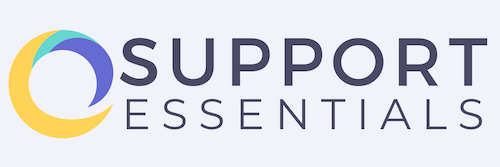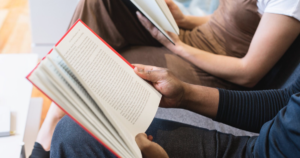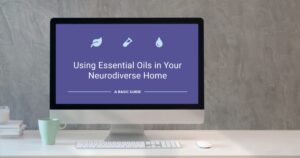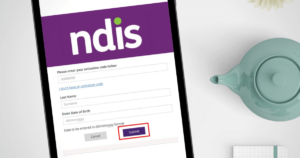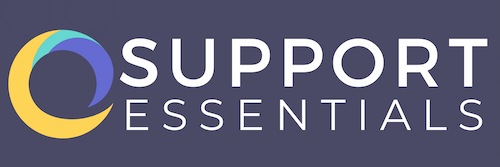Books About Puberty for Neurodivergent Females
Growing-up is one of life’s biggest transitions. I think everyone can admit that the passage through puberty can be a little challenging – more so if you already struggle with basic transitions like autistic children do.
So today I’m sharing four books about puberty to support autistic girls and other neurodivergent children.
None of these books will appeal to EVERY autistic girl because each autistic person is different.
Some of these books are written specifically with an autistic audience in mind, some of them are not, but I’m recommending these books because each of them is presented in a way that will appeal to a certain part of the spectrum.
Below I’ve provided a review of each book highlighting its unique attributes and the learning style it best supports (i.e. visual learners or linguistic (reading and writing) learners) so you can choose which book would best support you or your child.
I’ve also listed several online stores where each book can be purchased. If you decide to buy a book, please consider using your purchase to support a small business or autism charity.
4 Reviewed and Recommended Books About Puberty to Support Autistic Girls
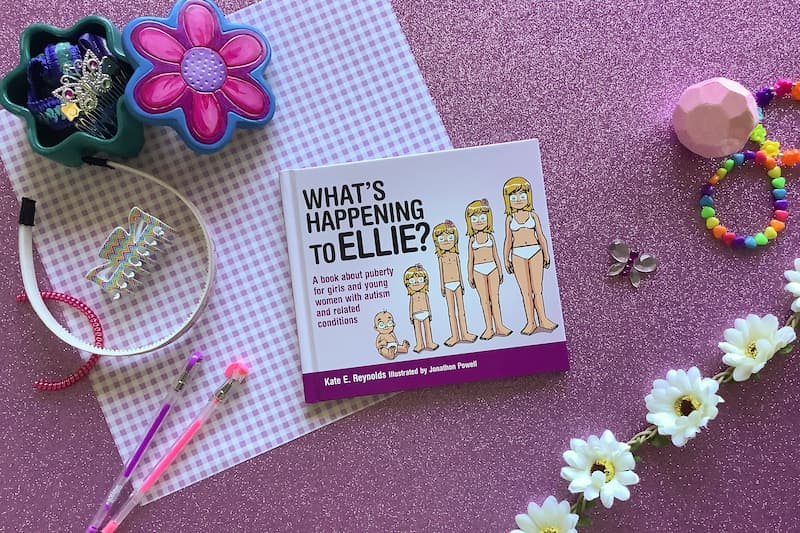
1. What’s Happening to Ellie?
Book Information
Title: What’s Happening to Ellie?
Subtitle: A book about puberty for girls and young women with autism and related conditions.
Author: Kate E. Reynolds
Illustrator: Jonathon Powell
First Published: 2015
Number of pages: 30
Basic Summary of What’s Happening to Ellie?
What’s Happening to Ellie? is a great little book to get started with learning about puberty as it is brief and to the point.
It is centred around a main character, Ellie, and what happens to her as she progresses though puberty.
This book only covers the basics, but its ‘About’ page does say that it has been “designed to read with a young person with autism, alongside other more generic reading material.”
Topics discussed
What’s Happening to Ellie? covers the following topics:
- Changes to the body during puberty (including pubic and armpit hair, pimples, breasts, hips)
- Periods (including period pain, sanitary pads, tampons)
- Hygiene (including showering, deodorant use)
- Growing Up
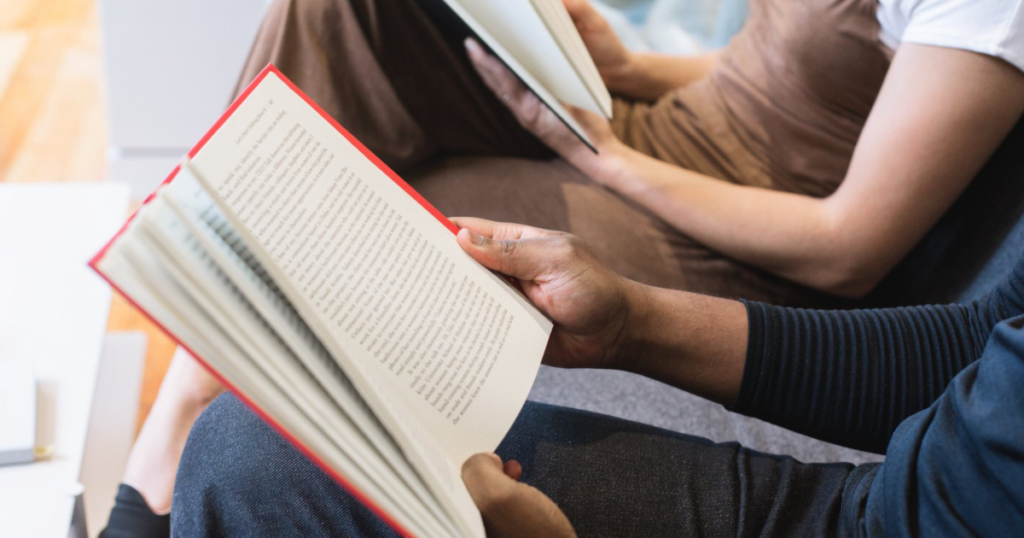
Tone of the book
What’s Happening to Ellie? has a hopeful and positive tone to reassure young people who may be anxious about future changes.
The written information is brief and succinct, with most topics limited to a two-page spread.
The book is laid out 50/50 in terms of text versus illustrations. The left-side page shares 1-2 paragraphs on a topic and the right-side page shows a related illustration. This is consistent throughout the book.
The book has small pages, measuring 18cm x 16cm.
The wording used is deliberately unambiguous and avoids confusing euphemisms.
Photos and Illustrations
What’s Happening to Ellie? has been very well illustrated and will appeal to visual learners.
This book contains nudity. The illustrations are explicit in order to convey the entire story, but somewhat less graphic in nature because they are illustrations and not real-life photographs.
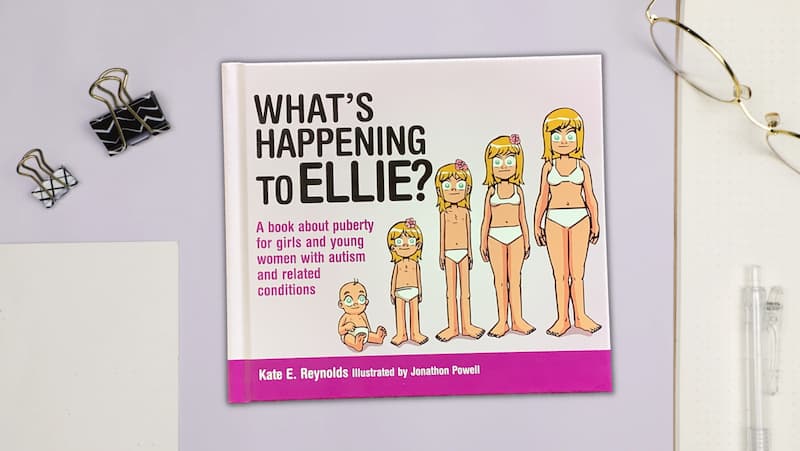
Author qualification and experience
The author, Kate E. Reynolds, is a Clinical Nurse Specialist and Senior Counsellor in the field of HIV/Aids and sexual health in the United Kingdom.
She is also the parent of an autistic child.
Other points of interest
What’s Happening to Ellie? is part of a series. There are two other books in this series about Ellie titled:
Ellie Needs to Go: A Book About How to Use Public Toilets Safely for Girls and Young Women with Autism and Related Conditions
Things Ellie Likes: A Book About Sexuality and Masturbation for Girls and Young Women with Autism and Related Conditions
An identical series exists for boys based around a boy character named Tom.
What type of reader would enjoy What’s Happening to Ellie?
What’s Happening to Ellie? will appeal to primarily visual learners who need a basic introduction to puberty to use alongside other resources, or as a basis for asking further questions.
Why What’s Happening to Ellie? comes recommended
The ‘short and sweet’ nature of What’s Happening to Ellie? makes it a good introduction resource that is direct and to the point, but brief and positive enough so as not to overwhelm young autistic girls.
Where to buy What’s Happening to Ellie?
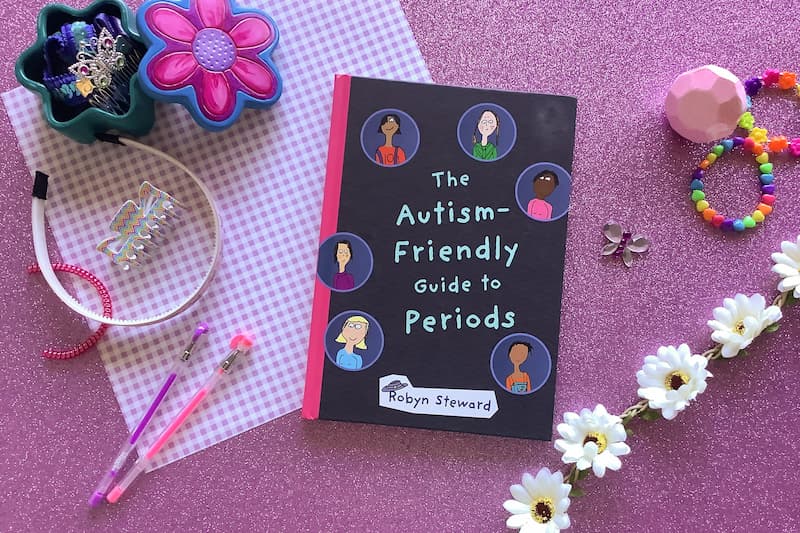
2. The Autism Friendly Guide to Periods
Book Information
Title: The Autism Friendly Guide to Periods
Author: Robyn Steward
Photography: Martin Delaney
First Published: 2019
Number of pages: 94
Basic Summary
The Autism Friendly Guide to Periods takes a very detailed and in-depth look at menstruation and periods and the implications for autistic girls.
Refreshingly it is written by ‘actually autistic’ author, Robyn Steward, and is essentially a very well organised info-dump.
This book is about periods only. There is no reference to puberty or the other body changes that happen during this time.
The Autism Friendly Guide to Periods goes to a lot of effort to explain the processes and reasons behind having a period and is great for those neurodivergent minds that hunger for detailed knowledge of how things work.
Topics discussed
The Autism Friendly Guide to Periods is divided into three parts.
Part 1: The Basics
This part consists of three chapters titled:
- What are Periods
- Period Supplies
- Common Period Worries
Part 2: Photos and Step-by-Step Guides
This part consists of 3D graphics of the reproductive system, plus text and photographic instructions about how to use disposable pads, cloth pads, tampons, and menstrual cups.
Part 3: A Bit More Detail
This part consists of two chapters titled:
- What Happens in the Body During a Menstrual Cycle?
- Autism Specific Issues with Periods

Tone of the book
The Autism Friendly Guide to Periods is very clear about what to expect when menstruating and offers concise instructions for what to do every step of the way.
It has also been written in a gender-neutral way so that a person of any gender will feel comfortable reading it.
Photos and Illustrations
Photographs and 3D graphics are used throughout The Autism Friendly Guide to Periods to show what having a period looks like in real life.
There is no nudity in this book, but there are pictures of menstrual blood, and pictures of parts of the female reproductive system taken with an internal body camera.
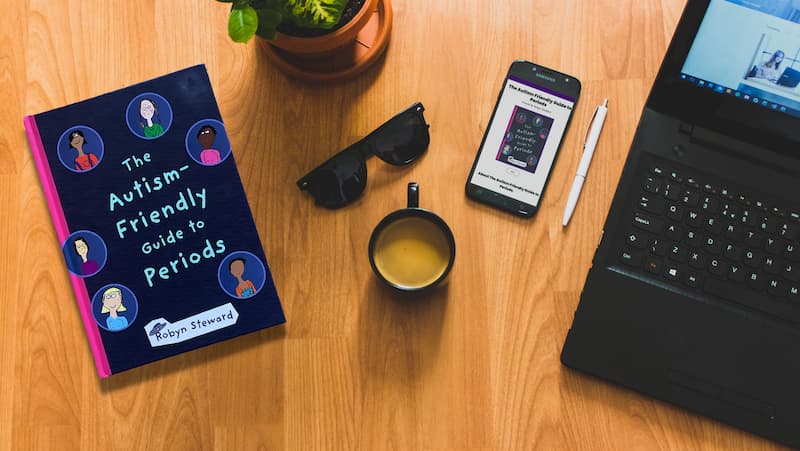
Author qualification and experience
Robyn Steward is an autistic author and an Honorary Research Associate at University College London. Her work has been peer reviewed by medical professionals.
Other points of interest
The Autism Friendly Guide to Periods has an accompanying website, often referred to in the book as a place to obtain extra information. The website also offers a ‘look inside’ and shows first 20 pages of the book if you want to have a look
The book has a flap system called ‘the frame’ which allows the reader to hide images until they are ready to view them. You can limit how much you see at once, or at all.
There is also a guide to making your own emotions glossary and a table to use to track your mood during your cycle.
As an example of the thoroughness of this guide, the author also makes mention of Premenstrual Dysphoric Disorder (PMDD) which is often little known and talked about as research on the condition is still developing.
What type of reader would enjoy The Autism Friendly Guide to Periods?
The Autism Friendly Guide to Periods is perfect for children who learn best by reading and writing, literal thinkers, and those who appreciate insights from adults who are actually autistic.
This book is also suitable for a person of any gender due to its gender-neutral tone.
Avoid The Autism Friendly Guide to Periods if you or your child may be triggered by the graphic nature of some of the book’s images.
Visual learners may also struggle with the amount of text.
Why The Autism Friendly Guide to Periods comes recommended
The Autism Friendly Guide to Periods is a refreshing autistic insight into the basics of menstruation that will definitely appeal to a neurodivergent brain.
It is also a valuable resource for any young woman wanting to know more about how their body works.
Where to buy The Autism Friendly Guide to Periods
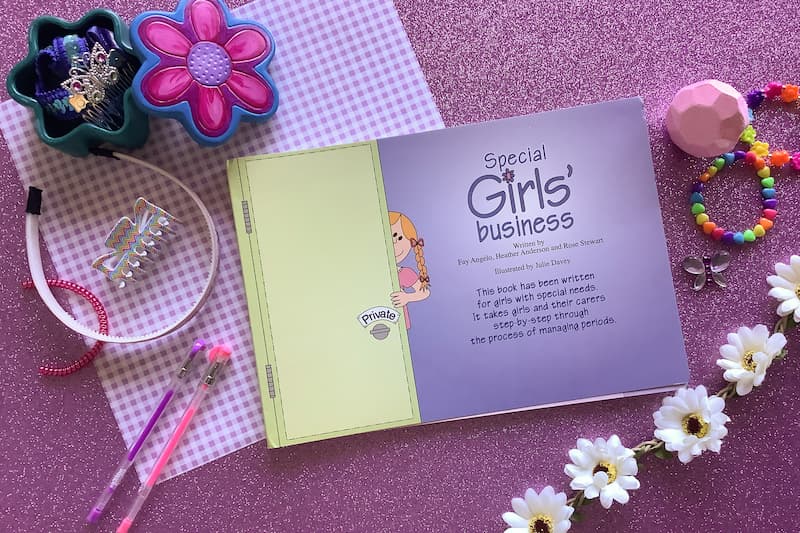
3. Special Girls’ Business
Book Information
Title: Special Girls’ Business
Subtitle: This book has been written for girls with special needs. It takes girls and their carers step-by-step through the process of managing periods.
Author: Fay Angelo, Heather Anderson and Rose Stewart
Illustrator: Julie Davey
First Published: 2005
Number of pages: 49
Basic Summary
Special Girls’ Business has been written for adolescent girls with any disability including:
- Intellectual disability
- Physical disability
- Communication disorder and
- Autism
The book aims to be inclusive, and the story is told using a range of different characters with different looks and abilities (one has braces on her legs, one uses a wheelchair, another uses a shower chair etc).
Special Girls’ Business is also suitable as guide for girls and their carers (that is, girls who require carers to help them go to the toilet and shower).
It also provides tips for mums, dads, carers, and teachers.
Topics discussed
Special Girls’ Business starts by discussing growing up and highlighting body changes during puberty.
It then progresses into detailed definitions and/or step-by-step instructions about the following topics:
- Periods
- Putting on a pad
- Taking off a pad
- Washing
- Shopping
- Privacy
- Feelings
Tone of the book
Special Girls’ Business has limited text and is mostly picture based. The text it does have is suitable for children with an intellectual disability.
The book is written in a friendly and inclusive manner, so any reader should be able to identify with one of the many characters used in the book.
Special Girls’ Business is laid out in an A4 landscape style, so it lays flat and has easy to turn pages.
You can see some sample pages of this book on the publisher’s website.
Photos and Illustrations
Special Girls’ Business is fully illustrated with hand-drawn images.
This book contains nudity and blood. While the illustrations are explicit, they are not very graphic in nature because they are illustrations, not photographs.
If you’re handy with a computer, the illustrations could be photographed or scanned and used to create a visual schedule for your child.
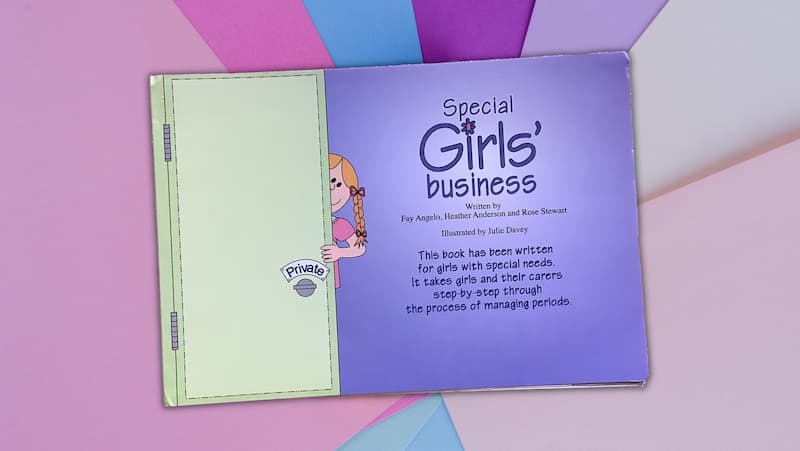
Author qualification and experience
Fay Angelo is an Assistant Principal, Pupil Welfare Coordinator and teacher.
Heather Anderson is a Sexual and Reproductive Health Nurse and Sexuality Educator
Rose Stewart is a teacher and Psychologist.
Other points of interest
Special Girls’ Business contains a section especially for dads with hints and tips about how to support their daughters.
The step-by-step illustrations in Special Girls’ Business can be photographed or scanned and used to create visual schedules and instructions.
Special Girls’ Business is one of many books published by Secret Girls’ Business, an Australian publisher of children’s books, specializing in puberty and sex education resources for young people, parents, carers, teachers, nurses and community groups.
It’s worth browsing through their other publications especially:
Puberty and Special Girls – provides practical information about growing up which will help girls understand the changes experienced at puberty.
Secret Girls’ Business – although this book is not specifically a disability puberty book, the simple text and illustrations make it appropriate for some girls and young women with special needs.
What type of reader would enjoy Special Girls’ Business?
Special Girls’ Business is ideal for visual learners and those with multiple disabilities (for example autism plus an intellectual disability, or autism and a communication disorder).
Why Special Girls’ Business comes recommended
Special Girls’ Business has illustrations that are perfect for creating your own visual schedules.
It is also the best book for girls with an intellectual disability (low-functioning autism).
It’s focus on inclusion (especially including dads) also earns it a big tick.
Where to buy Special Girls’ Business
Secret Girl’s Business Publishing
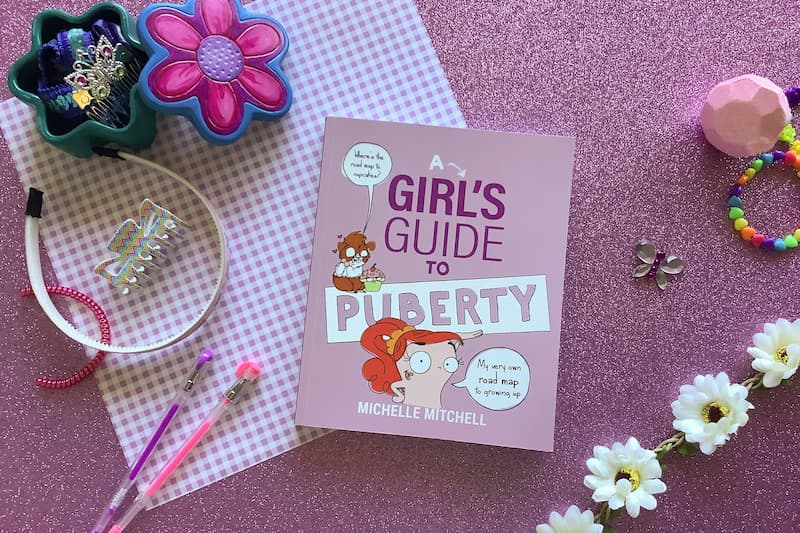
4. A Girl’s Guide to Puberty
Book Information
Title: A Girl’s Guide to Puberty
Author: Michelle Mitchell
Illustrator: Steph Cooper
First Published: 2020
Number of pages: 253
Basic Summary
Touted as a “no-pressure place to learn about your body”, A Girl’s Guide to Puberty is a relaxed and light-hearted road map to growing up.
Centred around its main character Olivia and her cupcake-loving guinea pig, Sprinkles, its pages are filled with comics, quotes and drawing pages alongside anatomy lessons and medical advice.
This is a BIG book (over 250 pages) and to be clear this resource is not directed at autistic children – it has been written as a guide for tweens in general – but it’s just too good not to be included in this book list.
Topics discussed
A Girl’s Guide to Puberty is divided into nine units:
- Talking to Adults
- Puberty Basics
- Hello Private Parts
- Body Changes
- More About Periods
- About Boy’s Bodies
- Looking After You
- Inside Your Brain
- The Future
Plus a ‘Puberty Vocab Guide’ (a glossary of terms about puberty)
Tone of the book
A Girl’s Guide to Puberty lays out all the facts about puberty and periods but with an engaging tone of humour, wit, and encouragement.
Its indirect style allows the reader to be privy to a conversation that the main character, Olivia, is having with the author about puberty and lets the reader overhear all the juicy bits of advice.
Most beneficial to our neurodivergent children is the way it models what to do and say in certain situations.
An emphasis on self-care and safety is also woven throughout.
Photos and Illustrations
A Girl’s Guide to Puberty is illustrated with hand drawn cartoon characters and anatomical caricatures (yes that’s a thing).
Kids will love the cartoon strips and all anatomical images are very accurate but toned down due to their cartoonish nature.
This book contains nudity and blood (or at least caricatures of nudity and blood).
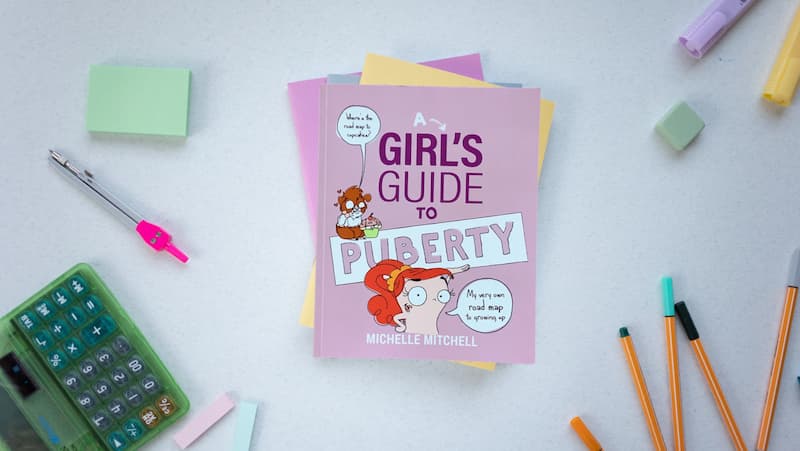
Author qualification and experience
Michelle Mitchell is an Australian teacher, public speaker, and author who surveyed over 560 tweens and aimed to answer all their questions in A Girl’s Guide to Puberty.
Other points of interest
A Girl’s Guide to Puberty contains a chapter on boys’ bodies to show that boys’ bodies do change during puberty too.
It also has a page dedicated to dads, but it gives advice from the kids’ perspective rather that the parent/carer – i.e. it models how to talk to dad.
A Girl’s Guide to Puberty is part of a series and has a brother book called A Guy’s Guide to Puberty.
What type of reader would enjoy A Girl’s Guide to Puberty?
A Girl’s Guide to Puberty is ideal for reading and writing learners with drawing pages and quotation colouring pages that invite you to really personalise your copy of the book.
Visual learners will get a kick out of the cute cartoons but may need someone to read the text to them.
Any autistic child who is SUPER literal might not appreciate the anatomical caricatures, and it’s best to avoid A Girl’s Guide to Puberty if your child would struggle to comprehend the humour and wit prevalent throughout this book.
Why A Girl’s Guide to Puberty comes recommended
The engaging and empowering tone of A Girl’s Guide to Puberty makes it a good read for any tween, but it’s the encouragement, conversation modelling, and emphasis on self-care that gets it over the line as a great resource for neurodiverse kids (or maybe it’s the guinea pig wearing a bra on page 72).
Where to buy A Girl’s Guide to Puberty

Audience Recommendations
Do you have a favourite puberty resource that you would recommend for an autistic child?
Detail your recommendation in the comments section below.
